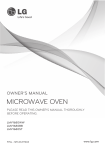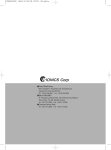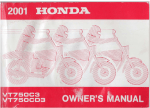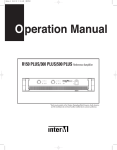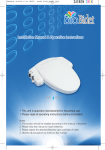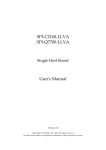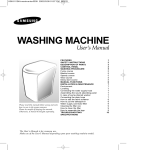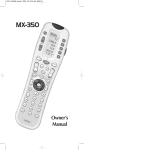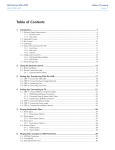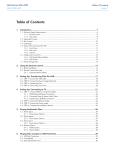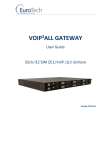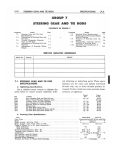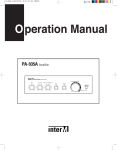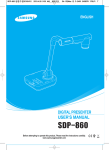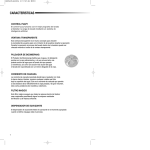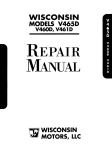Download 영문-메뉴얼표지 2005.12.29 3:57 PM 페이지1
Transcript
영문-메뉴얼표지 2005.12.29 3:57 PM 페이지1 영문-메뉴얼작업 2005.12.29 4:55 PM 페이지1 IMPORTANT NOTICE ●OPERATOR AND PASSENGER This motorcycle is designed to carry the operator and one passenger. ●ON-ROAD USE This motorcycle is designed to be used only on the road. ●READ THIS OWNER'S MANUAL CAREFULLY Pay special attention to statements preceded by the following words: Indicates a strong possibility of severe personal injury or death if instructions are not followed. Indicates a possibility of personal injury or equipment damage if instructions are not followed. Gives helpful information. This manual should be considered a permanent part of the motorcycle and should remain with the motorcycle when resold or othe rwise transferred to a new owner or operator. 영문-메뉴얼작업 2005.12.29 4:55 PM 페이지1 CONTENTS SPECIFICATION ...................................................................... 3 OPERATION INSTRUCTION ............................................ 4 HORN BUTTON................................................................. 15 WINKER SWITCH ............................................................. 15 SAFETY PRECAUTIONS .................................................. 4 PASSING LIGHT SWICH .................................................. 15 PRIOR TO STARTING VEHICLE ........................................ 5 CORRECT ATTIRE ............................................................. 6 EQUIPMENT USAGE........................................................ 16 OPERATION ........................................................................ 7 CARGO ................................................................................ 7 MODIFICATION ................................................................... 8 ATTACHMENT .................................................................... 8 MUFFLER ............................................................................ 8 PARTS LOCATION.............................................................. 9 METER READING AND USAGE................................... 12 METER .............................................................................. 12 TACHOMETER .................................................................. 12 FUEL GAUGE .................................................................... 12 STEERING WHEEL LOCK ................................................ 16 TOOL BOX ......................................................................... 16 FUEL .................................................................................. 16 CORRECT DRIVING OPERATION .............................. 17 STARTING THE ENGINE .................................................. 18 IF ENGINE CANNOT BE STARTED ................................. 19 GEAR SHIFTING ............................................................... 19 OPERATION ...................................................................... 20 HOW TO USE BRAKE....................................................... 20 PARKING ........................................................................... 20 SELF INSPECTIONS BEFORE OPERATION .......... 21 SWITCH OPERATION ...................................................... 13 INSPECTION OF CONCERNED AREA ............................ 21 BRAKES ............................................................................ 22 MAIN SWITCH .................................................................... 13 HEADLIGHT・POSITION LAMP ....................................... 14 TIRES ................................................................................ 24 BATTERY .......................................................................... 25 STARTER BUTTON .......................................................... 15 THROTTLE OPERATION .................................................. 26 CLUTCH ............................................................................ 27 INDICATOR LAMPS .......................................................... 13 1 영문-메뉴얼작업 2005.12.29 4:55 PM 페이지2 DRIVE CHAIN ................................................................... 28 ENGINE OIL LEVEL CHECK ............................................. 28 CHANGING ENGINE OIL .................................................. 29 LIGHTS AND WINKER ...................................................... 30 BACK MIRROR .................................................................. 30 LICENSE PLATE ............................................................... 30 FRAME AND ENGINE NUMBERS .................................... 30 MAINTENANCE .................................................................. 31 MAINTENANCE SCHEDULE ............................................ 32 MAINTENANCE PRECAUTIONS ...................................... 34 AIR CLEANER ELEMENT ................................................. 35 IDLE SPEED ADJUSTMENT ............................................. 35 WHEEL DISASSEMBLE .................................................... 36 SIDE STAND ..................................................................... 37 2 SAFE DRIVING ....................................................................... 42 PREPARATION BEFORE DRIVING ............................ 42 DRIVING METHOD ............................................................ 44 DRIVING POSITION ...........................................................44 PRECAUTION WHEN DRIVING ....................................... 43 STARTING ......................................................................... 45 TURNING METHOD ...........................................................46 PRINCIPLE OF TURN ....................................................... 46 EFFECT OF SPEED .......................................................... 46 3 POSITIONS OF TURNING ............................................. 47 TURNING METHOD .......................................................... 48 PRECAUTION WHEN TURNING ...................................... 49 BRAKING METHOD .......................................................... 50 SPARK PLUG .................................................................... 38 FUSE REPLACEMENT ..................................................... 39 BASIC PRINCIPLE OF BRAKE(FRICTION FORCE) ........ 50 RESTRAINT OF BRAKE EFFECT (INERTIA) .................. 50 BRAKING METHOD .......................................................... 51 CABLE RUBBER PART ..................................................... 40 CLEANING ......................................................................... 40 COMPARISION OF BRAKING DISTANCE ........................51 IMPACT WHEN COLLISION ..............................................51 STORAGE GUIDE ............................................................. 41 WIRING DIAGRAM................................................................ 52 영문-메뉴얼작업 2005.12.29 4:55 PM 페이지3 SPECIFICATION ITEM DATA ITEM DATA LENGTH×WIDTH×HEIGHT(mm) 2,110×795×1,160 IGNITION SYSTEM C.D.I WHEEL BASE(mm) 1,357 BATTERY CAPACITY 12V 9AH GROUND CLEARANCE(mm) 167 FUEL CAPACITY(ℓ) 10.5 SEAT HEIGHT(mm) 732 WEIGHT(kgf) 127 PASSENGER 2 ENGINE TYPE TIRE SIZE SUSPENSION AIR COOLED 4 STORKE 4 VALVE BRAKE FR. 90 / 90 - 18 RR. 110 / 90 - 16 FR. TELESCOPIC RR. SWING ARM FR. HYDRAULIC DISK RR. DRUM BRAKE PISTON DISPLACEMENT(cc) 124.1 BORE AND STROKE(mm) 56.5×49.5 SPARK PLUG CR8EH-9 STARTING SYSTEM START MOTOR / KICK FUSE(A) 15A TRANSMISSION TYPE 5 STEPS RETURN 3 영문-메뉴얼작업 2005.12.29 4:55 PM 페이지4 OPERATION INSTRUCTION This manual describes matters pertaining to correct operation, safe operatio n and simple maintenance of the v ehi cle y ou purchased. To ensure more comfortable and safer operation, make sure to read this manual carefully prior to operation. ●The photographs and drawings shown in this manual may differ from those of actual vehicles due to changes in vehicle specifications and modifications made. ●Th is motorcycle is design ed for 2 ri ders in cludi ng the operator. ●Do not use polluted gasoline. O therwse it cause rust inside the fuel tank, and close the supply of fuel to the carburetor, leading t o an imp roper en gine startin g or may cause serious damage to an engine. ●Do use genuine oil to protect and extend vehicle life. ●As far as any defect cau sed b y co ntaminated gasoline or oil, no warranty shall be assured. 4 SAFETY PRECAUTIONS ●Careful driving and the wearing of proper attire and safety equipment are the most important factors in the safe operation of the vehicle. Please obey traffic regulations and do not be hurried and careless. ●Many new vehicle ow ners operate their newly purchased vehicles w ith great care an d attentio n to safety factors. However, after becoming accustomed to the operations are often discarded, which can lead to accidents. Please don't let this happen to you and always approach the operation of your vehicle with the safety considerations needed. When operating the motorcycle, always keep in mind and ob ey t he no tes o f precaut io n pri nt ed on th e“ S a f e t y Precaution Label”attached to the motorcyle. ●Be sure to wear helmet at all time. ●Be sure to put on gloves at all time. ●Observe the speed regulations. ●Beware of muffler after driving as it is still hot to be burnt. Especially never children touch on it. ●For safety, do not change, alteration or modification the vehicle. ●Regularly conduct specified maintenance inspections. <Maintenance Inspection Points> Brakes, Tires, Oil, Lights, Horn, Instruments 영문-메뉴얼작업 2005.12.29 4:55 PM 페이지5 PRIOR TO STARTING VEHICLE ●Read user's manual carefully. ●Conduct maintenance checks prior to operation. ●Always maintain motorcycle in clean statu s and carry out specified maintenance checks. ●Make sure to stop engine and stay away from fire when fueling. ●Exhau st gas co ntains h armful sub stance s uch as carb on monoxide. Start engine in well-ventilated places. ● Don’t drive with one hand, Hold the handle tightly with both hands. ● When carrying goods, securely fasten them. ● Using one hand or no hands while driving may cause an accident resulting in severe injury. ● For safety, Be prohibited the riding with children as passengers (as above photo) Otherwise, this may cause severe injury. 5 영문-메뉴얼작업 2005.12.29 4:57 PM 페이지6 CORRECT ATTIRE ●Always make sure to wear helmet for safety. Wear gloves and safety goggles. ●D o not wear uniforms w hich might hinder operation. It is dangerous if the uniform is caught by brake lever or by the rotating part of drive chain. ●Do not wear slippers which might obstruct brake operation or transmission gear operation. ●Many automobile/motorcycle accidents happen because the automobile driver does not “see” the motorcyclist. Make yourself conspicuous to help avoid the accident that wasn’t your fault : - Wear bright or reflective clothing. - Don’t ride in another motorist’s “blind spot”. Be sure wear helmet at al l time and the hel met chin strap securely fastened. W ear shi rts or jackets with tight Always put on gl oves. ●Not wearing a helmet increases the chance of serious injury or death in a crash. ●Be sure you and your passenger always wear a helmet, eye protection and other protective apparel when you ride. 6 Choose fi tting and low-heeled shoes 영문-메뉴얼작업 2005.12.29 4:58 PM 페이지7 OPERATION CARGO ●When carrying cargo, you must keep in mind that operating ●Operators should naturally fix bodies to keep smooth driving. the motorcycle, especially when turning, will be different. ●Please check whether or not you are unnaturally strained and ●Make sure not to overload the motorcycle with goods as this strung up. can make the motorcycle unstable during operation. ●Driving pose has a great influence on safe operation. Please always maintain the center of your body in the middle Securely fasten them of seat. Especially do not sit at the rear seat because it may lessen the weight of front wheel and cause trembling steering wheel. ●A passenger should hold on to the vehicle or the operator with both hands and keep both feet on the pillion step bar. ●When wanting to turn, slightly lean to body toward the direction of the turn. It is unsafe if the body is not moved in union with the vehicle. ●Curvy roads and poor, unpaved roads constantly change in surface quality. Driving o n these roads can be unsafe if certain safety precautions are not followed. ●In order to safely drive through these driving conditions, ●Pay attention not to overload goods and fasten it anticipate coming road conditions, slow down to at least half tightly whiling driving. the normal speed, and relax your shoulders and wrists while ●Overloading or improper loading may cause securely holding the handles. a crash and severe injury. ●Driving with one or both hands not holding the handles ●Do not attach large or heavy items (such as a cause severe injury or death of the driver resulted from the sleeping bag or tent) to the handle bars or fork. turnover of the vehicle. Unstable handling or slow steering response may result. 7 영문-메뉴얼작업 2005.12.29 4:58 PM 페이지8 MODIFICATION ●Modification of veh icle structu re of function deteriorates manipulatability or causes exhaust noise to become louder shortening the vehicle life. These modifications are not only prohibited by law but also are the acts harmful to other people. MUFFLER ●Pay particular attention to fellow passenger so that he or she can prevent getting burnt by the hot muffler during travel. ●Modifications : no warranty shall be assured. ATTACHMENT ●Except design ated attachment by DAEL IM MOTO R CO ., LTD., don't attach any extra lighting device, otherwise it cause premature discharging of battery. ●Carefu lly in spect the accessory to make sure it does not obscure any lights, reduce ground clearance and banking angle, or limit suspension travel, steering travel or control operation. ●D o n ot ad d elect ri cal equ ip ment t hat w il l exceed the motorcycle’s electrical system capacity. A blown fuse could cause a dangerous loss of lights or engine power. ●This motorcycle was not designed to pull a sidecar or trailer. Handling may be seriously impaired of so equipped. 8 ●Beware of muffler after driving as it is still hot to be burnt. Eapecially never children touch on it. ●Pay attention to park where pedestrian zoon. ●If haystack or vinyl is stuck to the muffler,it might be fired 영문-메뉴얼작업 2005.12.29 4:58 PM 페이지9 PARTS LOCATION SPEEDOMETER BACK MIRROR TACHOMETER FUEL GAUGE CHOKE LEVER BACK MIRROR FRONT BRAKE FLUID RESERVOIR FRONT BRAKE LEVER PASSING SWITCH THROTTLE GRIP CLUTCH LEVER HEADLIGHT SWITCH HEADLIGHT DIMMER SWITCH STARTER BUTTON WINKER SWITCH HORN BUTTON FUEL TANK CAP MAIN SWITCH 9 영문-메뉴얼작업 2005.12.29 5:0 PM 페이지10 PARTS LOCATION FRONT BRAKELEVER FUEL TANK CAP BACK REST TOOL BOX TAIL LIGHT FRONT TIRE REAR TIRE PILLION STEP BAR 10 BATTERY/FUSE MAIN STEP BAR REAR BRAKE PEDAL BRAKEDISK 영문-메뉴얼작업 2005.12.29 5:1 PM 페이지11 PARTS LOCATION CLUTCH LEVER MAIN SWIT CH FUEL COCK FRONT CUSHION REAR CUSHION PILLION STEP BAR GEAR CHANGE PEDAL AIR CLEANER ELEMENT MAIN STAND SIDE STAND 11 영문-메뉴얼작업 2005.12.29 5:2 PM 페이지12 METER READING AND USAGE FUEL GAUGE METERS Indicates amount of gasoline in fuel tank. (The fuel gauge needle always indicates gasoline level regardless of whether main switch is in "OFF" position or in "ON" position.) If needle is within " E" mark, immediately fill gasoline. Balance at this time is approxi-mately 1.0 litres. <SPEEDOMETER> Indicates s peed in km/h during travel. Maintain legal speed limits to ensure safe operation. <ODOMETER> Indicates total operating distance in km. <TRIP METER> Indicates travel distance from the point the meter is reset to “0”. To reset meter, turn the trip meter knob to the direction of arrow. SPEEDOMETER ODOMETER TRI P METER 12 TR IP M ETER RESET KN OB TACHOMETER Indicates engine revolutions. (rpm) FUEL GAUGE ●Make sure, during travel, the tachometer needle cannot be entered danger zone(red zone) due to excessive engine running. ●Pay particular attention because idle engine running or abrupt acceleraion in the 1st or 2nd gear may cause the tachometer needle to be in thedanger zone(red zone). Danger zone means the engine revolution limit and, if engine is run beyond this danger limit, engine will be damaged. TACHOMETER DANGER ZONE(RED ZONE) 영문-메뉴얼작업 2005.12.29 5:2 PM 페이지13 INDICATOR LAMPS SWITCH OPERATION MAIN SWITCH Winker blinks when turn signal lamp is blinking. <HEADLIGHT HIGH-BEAM INDICATOR> Turned on when the headlight is in highbeam position. Main switch is used to turn on or turn off engine Key position WINKER <NEUTRAL INDICATOR> Turned on when the main switch is in “ON” position and gear is in neutral position. <WINKER INDICATOR> If main switch is turned “ON” and winker is activated, the winker located in the direction of turning is turned “on” ON Starts engine. Power is Key cannot supplied to electrical be removed circuits OFF Stops engine. Cuts off all electrical circuits. Can be removed Cut off all electrical circuits and steering wheel is locked Can be removed LOCK OFF HEADLIGHT HIGH-BEAM INDICATOR Key removal Function ON NEUTRAL INDICATOR KEY MAIN SWITCH LOCK 13 영문-메뉴얼작업 2005.12.29 5:3 PM 페이지14 SWITCH OPERATION ●Do not operate main switch key while driving. If the main switch key is placed on“Off”or “Lock”position, all electrical system will not function. ●Do not operate the main switch key during travel as it might cause unexpected accidents, If it is necessary to remove the main switch key, stop the vehicle first prior to removing. ●Prior to dismounting from the vehicle,make sure to lock the steering wheel and remove key. Switch position Funcation H Headlight and tali/stop light turned on P Position lamp and taillight tu rned on . L ight turned off ●When you travel after sunset, put headlight in low-beam. This lets approaching vehicles know of your position and is helpful for safe driving. HEADLIG HT SW ITCH HEADLIGHT・POSITION LAMP <TURNING ON HEADLIGHT> Put main switch key in “ON” position and turn on headlight switch. 14 <HEADLIGHT HIGH OR LOW BEAM OPERATION> High beam or low beam can be operated by the use of high/low beam switch. HI... Headlight placed on high beam LO... Headlight placed on low beam HEADLIG HT HIG H/LOW BEAM S WI TCH 영문-메뉴얼작업 2005.12.29 5:4 PM 페이지15 STARTER BUTTON HORN BUTTON If you press this button, starter motor runs and engine is started. If horn button is pressed when main switch is in “ON” position, horn is sounded PASSING LIGHT SWITCH This switch is used to let other operators know your intention of passing other vehicles. <HOW TO USE> Press passing light switch PAS SIN G LIGHT SWITCH HORN BUTTON WINKER SWITCH STARTER BUTTON ●Do not press starter button repeatedly because it consumes great amount of power causing battery to be exhausted sooner. Use winker switch when you turn to left or right <HOW TO USE> If this switch is turned on when the main switch is in “ON” status,winker is brinking. To release winker operation, return winker switch to its original position. R .... Turn to right L .... Turn to left WINK ER SWITC H ●If the headlight is placed on highbeam, this switch will not operate. 15 영문-메뉴얼작업 2005.12.29 5:4 PM 페이지16 EQUIMENT USAGE STEERING WHEEL LOCK To prevent from being theft, lock steering wheel when parking the vehicle. <HOW TO LOCK> ① Tu rn th e st eeri ng wh eel to left completely. ② Insert main switch key. ③ Turn the key 180° to the right. If the steering wheel cannot be locked, mov e the s teering wh eel sligh tly to right and left while turning the key. ④ Remove the key. <HOW TO RELEASE> Release in the reverse order of locking MAIN SWITCH KE Y ●T o mak e su re s teerin g w heel is locked properly, lightly turn steering wh eel to left and rig ht and verify lock. ●Park the v ehi cle i n p laces free o f traffic. ●Prior to operation, turn the steering wheel to left and righ t to verify if turning angles of left and right are equal. TOOL BOX Tool box is behind the seat. Safeguard owners manual or maintenance note book can be kept in this box. Check gasoline to sec if the gasoline level is sufficient to operate vehicle to destinations. <REFULELING> ●Open key cover ; insert main switch key ; turn key to right and fuel tank cap is opened. ●Fill gasolin e up the bo ttom o f lev el plate located at the lower side of tank mouth. ●Push the tank cap correctly with hands and remove the main switch key. (If the fuel tank cap is not locked, the main switch key will not be removed) <HOW TO USE> Use main switch key to open or close the tool box cover. TOOL BOX 16 INSPECTION BEFORE STARTING FUEL CHECK ●Make sure to stop engine and st ay away fro m fire wh en fueling. ●If gasoline is filled aboved the level plate bottom, gasoline may overflow. 영문-메뉴얼작업 2005.12.29 5:5 PM 페이지17 FUEL COCK LEVEL PLATE BOTTOM CORRECT DRIVING OPERATION put the lever in “RES” position and repuel immediately. After refueling return the lever to “ON”position. Reserve fuel capacity: Approximately 1.0 liter FUEL TANK CAP <FUEL COOK> The fuel cock lever arrow indicates operating position. ●ON . . . .Gasoline is supplied.Set fuel cock to this position when starting engine ●OFF....Fuel is not supplied. Set to this position except when the vehicle is operated ●RES....Indicates reserve fuel. If fuel runs out while driving with the fuel cock lever placed in the “ON” position, ●Make sure to check th e oil, gasoline, etc., before starting the engine. ●Please ensure that the main stand and the side stand are in a up -po sition when starting the engine. ●Make sure that the front wheel is locked when starting the engine. ●Drive with care for both safety reasons and longer vehicle life. ●For 1 mo nth(or 1,000 km) after purchasing the vehicl e, dri ve moderately avoiding fast starts and fast acceleration. ● Keep holding the brake lever at start-up ●If th e l ev er i s no t turn ed to “ON” reserve, fuel will run out during travel and vehicle cannot be operated. in order to prevent the vehicle from springing out and causing injury. ● Do not operate the throttle while the main stand is set. Otherwise, the rear wheel may touch with the ground and cause injury due to a sudden movement of the vehicle. 17 영문-메뉴얼작업 2005.12.29 5:5 PM 페이지18 STARTING THE ENGINE <WHEN ENGINE IS COLD(WINTER)> 1. Make sure fuel cock lever is in “ON” position. 2. Turn on main switch. 3. Put gear in neutral. (Verify this with neutral indicator lamp) 4. Open choke lever all the way. 5. Close throttle gri p and p ress starter button. 6. Once engine is started, pull and release throttle grip repeatedly to run engine idle until engine is heated, and close cho ke l ever com plet ely. If eng ine warming up takes time, run engine idle with the choke lever slightly closed. 7. Verify sid e s tan d is p os iti vely in original position and start slowly. 18 CHOKE LEVER 4. Clo se thrott le grip and pres s s tarter button. (If engine is not started with 1-2 times of trial, verify fuel cock lever is in “ON” position) 5. If engine is not started with throttle grip closed, open throttle grip approximately 1/8 to 1/4 and press starter button. 6. V erify si de st and i s po sit iv ely in original position and start slowly. ●If engine cannot be started, refer to next page for more details. 1/8 1/4 <WHEN ENGINE IS HOT(SUMMER)> 1. Make sure fuel cock lever is in “ON” position. 2. Turn on main switch. 3. Put gear in n eut ral.(V erify thi s w ith neutral indicator lamp) 영문-메뉴얼작업 2005.12.29 5:5 PM 페이지19 IF ENGINE CANNOT BE STARTED ●E xhaust gas contains harmful s ub stan ce su ch as carb on monoxide. Start engine in wellventilated places. ●If engine is not started within 3 seco nds after starter bu tto n is pressed, wait for approximately 10 seconds and retry. This is to recover battery voltage. ●Do not run engine idle unreasonably. This not only wastes fuel b ut als o adv ersely affects engine. ●If st art er b ut ton is p res sed w it hou t di seng agi ng clu tch, mo torcy cl e may b ri ng out to fall. Make sure gear is in neutral p osi tion o r dis en gage cl utch prior to starting engine. If engine cannot be started or vehicle does not move, check the followings. ●Is there fuel in fuel tank? ●Are you operating in accordance w ith the instructions given in user’s manual? ●Is fuse not cut? ●Is starter motor running? ●If starter motor is not running due to battery consumption, try starting motor by using kick start technique. <GEAR DOWN OPERATION> If you gear down when you need to drastically accelerate speed such as when you are passing another vehicle, speed can be accelerated. If y ou ride t oo fast, it ad versely affects engine because engine revolution is excessive. 23 4 5 GEAR SHIFTING Gear is shifted in 5-shift return system as shown on the right side drawing. ●Close throttle grip and hold clutch lever perfectly, and shift gear. ●Touch pedal lightly with foot and shift gear perfectly until you hear “Click” at the pedal. If you apply excessive force when shifting gear, transmission may be damaged. 1 GEAR CH ANGE PEDAL 19 영문-메뉴얼작업 2005.12.29 5:5 PM 페이지20 OPERATION ●Make sure s ide stand is in o rig inal position prior to starting vehicle. ●If side stand mo ves unsatisfactorily, check lubrication state on side stand joint. ●Shi ft g ear adequ ately accordin g to vehicle speed. ●To save fuel an d maintain optimum v ehicl e l ife, do n ot accelerate o r decelerate speed abruptly. ●Start carefully as slow as possible. ●If you hear abnormal noise during travel, contact authorized maintenance shop immediately for inspection and necessary action. ●Maintain legal speed limits. <BREAK-IN OPERATION> Maintain engine revolution at a level less than 6,000rpm for first 1,000km to break in vehicle. If vehicle is broken in as above, the life span of equipment is prolonged. 20 HOW TO USE BRAKE ●Apply brakes on front wheel and rear wheel simultaneously. ●Avoid unnecessary abrupt braking. ●If you apply brakes only on front wheel or rear wheel, vehicle may slide off sideway and fall. ●If you apply brakes abruptly during travel in rain or on wet road, tires slide off and may cause accidents. Reduce speed and apply brake cautiously. ●Avoid repeated brake operation as it may cause brake temperature to rise, leading to braking effect deterioration. <ENGINE BRAKE> If you turn throttle grip in reverse, engine brake functions and, if you need stronger braking, shift gear down from 4th to 3rd and so forth. When you travel on a long d es cent or o n a sh arp d escent , us e intermittent braking technique and engine brake simultaneously. ●A brupt downshift may cause the shake of rear parts. PARKING ●Put gear in neutral and put main switch to “OFF” position to stop engine. ●Put fuel cock to “OFF” position. ●Put vehicle on main stand and park on level ground in places free of traffic. If you park vehicle on an uneven ground, vehicle may fall. ●Select a safe place free of traffic and park vehicle. ●Muffler is hot. Park vehicle in places where there is no danger for people to contact with vehicle. <PARKING WHEN SIDE STAND IS USED> Stop vehicle on level ground and park with the steering wheel turned to left. If the vehicle is parked in the following way, vehicle may fall to side. ●If the vehicle is parked with the steering wheel turned to right, or if parked on a slope, sandy places, uneven ground or soft ground, vehicle may fall. ●If is necessary to park in an unstable ground under unavoidable situation, take su fficient s afety measures to prevent vehicle from falling or moving. 영문-메뉴얼작업 2005.12.29 5:6 PM 페이지21 SELF INSPECTIONS BEFORE OPERATION Self i nsp ect th e mot orcycle an d have regu lar mai nt enance in spect ion s for increased s afet y and the p revention of accidents. Self inspections before operation should be perfo rm ed an a d aily b asi s prio r t o operating the vehicle. ●Inspections of areas of concern. ●Fuel check ●Brake inspection ●Tire inspection ●Battery acid level inspection ●Throttle grip Inspection ●Clutch inspection. ●Drive chain inspection. ●Engine oil inspection. ●Lights and winker inspection. ●Back mirror inspection. ●License plate inspection. INSPECTION OF CONCERNED AREA Ob serve safety rul es w hen conducting inspections. ●Exhaust gas contains harmful s ubs tan ce su ch as carb on mono x-ide. Do n ot carry out inspections on vehicle in closed places, or in poorly ventilated places, with engine running. ●Con duct ins pection s on flat, s oli d gro und wit h th e s tand erected. ●Be careful of burns when conducting inspections immediately after engine is stopped because the engine and muffler are hot. ●Stop engine and remove the key prior to the vehicle maintenance service. ●If y ou are u nab le t o correct trou ble ev en after y ou make ad jus tmen t or co rrecti on , contact authorized maintenance sh ops , dealers or d es ign at ed repai r sh op s for n ecess ary inspection and repairs. Check areas which caused for concern when last operating the vehicle. 21 영문-메뉴얼작업 2005.12.29 5:6 PM 페이지22 SCREW BRAKE CHECK MASTER CYLINDER CAP FRONT WHEEL <BRAKE OIL INSPECTION> Put main stand in upright position on a flat ground and operate steel wheel, and check flui d w hen th e to p o f master cylinder cap is level. Check flu id level t o see if it is below lower level. If fluid significantly is in low level, it may indicate fluid leakage on brake system. If this happens, check fluid leaks or brake system. If this happens, check fluid leaks or damage on system and inspect joints and clamps for looseness. In add iti on, check h ose and p ipe protective part to sec if they make contact with other parts when you make left or right turn due to vibration during travel. ●Brake i s an i mpo rtant part which protects your life. Make sure to inspect brake prior to daily use. REPLENISHING BRAKE OIL ●Move steering wheel and set the top of reserve tank level. ●Clean dust and oth er foreign matter from around master cylinder and take caution not to allow foreign matter to fall inside master cylinder ●Open cap screw and remove diaphragm. ●Replenish recommended brake fluid to u pp er level in sid e mas ter cyl ind er. Tighten cap accurately, paying attention t o t he d irecti on of diap hragm assembling, and avoid ingress of foreign matter. RECOMMENDED BRAKE IS DOT 3~4 LOWER LEVEL 22 DIAPHRAGM PLATE DIAPHRAGM UPPER LEVEL ●Do not fill brak e fl uid abo ve upp er level as i t may caus e brake fluid to leak outside. ●Ex erci se full cau ti on, w hen replenishing brake fluid, not to al lo w du st or water to mix inside master cylinder. ●If the amo un t o f brake fl uid decreases considerably, it is an ind icati on of b rake sy st em trouble. ●To preven t o ccurrence o f ch emi cal change, do not u se brake fl uid o f different manufacturer. ●Do not let brake fluid contact vehicle parts because it causes damage to painted parts. 영문-메뉴얼작업 2005.12.29 5:7 PM 페이지23 BRAKE INSPECTION FRONT WHEEL <BRAKE PAD INSPECTION> Operate brake and, if the brake pad wear limit line reaches the brake disc side, it indicates the pad has reached wear limit. After adjustment, push the brake pedal with hands until you feel resistance and check to see if the pedal free play is within prescribed range. <BRAKE SHOE INSPECTION> Push brake pedal completely and, if the brake arm arrow and the “△” on brake panel match each other, it indicates brake shoe has reached its life limit. BRAKE PEDAL FREE PLAY : 20~30mm P A D W EAR LIMIT LINE “△” MARK ARROW MARK BRAKE PADAL REAR WHEEL Push the brake pedal with han ds for resistance and check if the pedal movement appropriate. If brake pedal movement is inappropriate, adjust the pedal free play using the rear wheel brake adjuster nut. ●To adjust pedal free play, turn adjuster nut. ADJUSTER NUT ●In case brake pad or shoe reaches the w ear li mit lin e, replace it immed-iately. Wo rn brake pad can cau se an accident due to lack of power 23 영문-메뉴얼작업 2005.12.29 5:8 PM 페이지24 TIRES <TIRE PRESSURE CHECK> Ch eck for an ap pro priat e lev el of ai r pressure by examining how the tire sits on the ground. If you notice any abnormalities in the shape of the tire with regard to the area contacting the ground, use a tire gauge to check tire pressure and adjust the tire pressure to the appropriate level. <CRACKS/DAMAGE> Check tire tread and sides for cracks and damage. <FOREIGN MATTER> Check tire tread and sides for nails, rocks, etc. That might have become wedged in the tire. CRACKS NAILS ROCKS <TIRE PRESSURE> 90/90-18 110/90-16 FRONT 1.75 1 PERSON TIRE RIDING REAR 2.00 PRESSURE 2 PERSON FRONT 1.75 (kg/㎠) RIDING REAR 2.25 SIZE × FRONT REAR DAMAGE <TREAD DEPTH> ●Check th e wear ind icato r(wear limit marking) to see if there is an insufficient <ABNORMAL WEAR> amount of tread remaining. Check ti re t read for s igns of abn ormal ●If the indicators are visible, replace tire wear. with a new one. WE AR IN DI CATO R (WE AR LI MIT MA R K IN G) × ABNORMAL WEAR 24 WEAR IND IC AT O R LO CATIO N MAR K ING 영문-메뉴얼작업 2005.12.29 5:8 PM 페이지25 ●If air pressure is inadequate or if there are cracks, damage o r abnormal wear on tires, it may cause trembling steering w heel and flat tire. ●Insufficient air pressu re may cause the heavy steering wheel marking handiling difficult, fuel over consumption and the excessive wear of tire outer area and excessive air pressure may cause easier wheel handling and lower fuel consumption. But it may also cause the excessive wear of tire centerr area. ●This vehicle is equ ipped with tubeless tires. If you have flat tires, please contact authorised maint-enance shops for inspection. BATTERY ACID LEVEL CHECK BATTERY ACID REPLENISHING ●Remove the four flange bolts, and take off the right lower cover. ●Place vehicle in upright p osition and check battery acid of each cell to see if it is between upper and lower level. If the battery acid is near lower level, replenish distilled water. ●Refer to page 34 for battery acid replenishing. If the battery acid is insufficient, replenish distilled water in the following sequence. ① Loo sen the bolt and o pen the battery band. ② Remove the battery breather tube from the battery. ③ Remove the negative pole side cord first and the positive pole side cord next. ④ Remove the battery and open the battery cap. Fill distilled water to near upper level. ⑤ Tighten the battery cap accurately to the vehicle and install battery. Make sure, at this time, that side cord is connected first, followed by side cord. UPPER LEVEL LOWER LEVEL 25 영문-메뉴얼작업 2005.12.29 5:9 PM 페이지26 BATTERY CAP CORD BOLT B ATTER Y B REATHER TUBE BOLT ●Stay away from when handling battery. ●When battery holder is opened, do not allow the side cord to contact metal part. 26 ●After installing battery, verify th e breath er t ub e has b een accurately assembled to elbow. If the breather tube is removed, the battery acid causes damage to adjacent parts. If the tube is bent and clogged, the battery in ternal pres su re rises an d battery case may be damaged. Follow instructions on the label attached to vehicle for correct checking procedure. ●If excessive amount of distilled water put in, it overflow s and cau ses corrosi on of affected part. ●Battery acid con tain s thi n sulfuric acid. Prevent its contact with eyes or skin as it causes damage if contacted. If battery acid gets on part of your body, immediately flush the affected area with clean for longer than 5 minutes, and co nsult medi cal doctor for necessary treatment. ●Make sure cords are not twisted or i nserted w hen assemblin g battery to battery holder. THROTTLE OPERATION ●Check for smooth rotation of the throttle grip from the fu lly open to the fully closed po sition at b oth full steering positions. ●Measure the throttle grip free play at the throttle grip flange. The standard free play should be approx. : 2~6 mm ●To adjust the free play, turn the adjuster. ADJUSTER ●O perating the motorcycle with an indequate throttle grip free play can b e hazardou s. Inadequate th rot tle grip free play can cause engine speed to rise suddenly when you turn the handlebars. 영문-메뉴얼작업 2005.12.29 5:9 PM 페이지27 CLUTCH <LEVER FREE PLAY INSPECTION> Pull clutch lever until you feel resistance, and using a graduated ruler, check the lever end free play to verify it is within prescribed level. <CLUTCH LEVER ADJUSTMENT> Adjust lever free play by using the clutch cable’s clutch lever sid e or clutch side adjuster. ●Clutch side lock nut and adjust with adjuster. ●For fine adjustment, loosen the clutch lever side lock nut and turn adjuster. ●A fter ad just men t is compl et ed , pu ll clutch lever with hands until you feel resistance and verify the lever end free play is within prescribed level. CLUTCH LEVER FREE PLAY: 10~20mm <CLUTCH OPERATION> ●When engine is idling, pull clutch lever all the way and see if there is abnormal noise or if you feel unusual heaviness. ●Slowly release clutch lever and start. Check at this time to see if clutch is engaged smoothly without slipping. ■MAJOR ADJUSTMENT LOCK NUT ADJUSTER ■FINE ADJUSTMENT LO CK NUT ADJUSTER ●Upon completion of adjustment, start engine and verify gear change pedal is operating smoothly. 27 영문-메뉴얼작업 2005.12.29 5:10 PM 페이지28 DRIVE CHAIN INSPECTION ●Put vehicle in upright position on main stand and move the center of front and rear sprocket up and down with hands to determine if the chain free play is within prescribed range. optima free play : 15~25mm ●If free play is great, loosen axle and put the left and right lock nuts, and make necessary adjustment by turning adjuster nut. ●Make sure the right and left chain adjuster graduation are set in the same position. ●Tighten an axle nut. ●Tightening torque :7.0Kg-m ●Tighten an adjuster nut,and tighten lock nut. ENGINE OIL LEVEL CHECK CHAIN ADJUSTER LOCK NUT AXLE NUT ADJUSTER NUT <DRIVE CHAIN INSPECTION> ●Check drive chain tension and spocket wear and damage. If roller is damaged or pin is loose,replace chain. ●If sprocket is worn or damaged,replace.Check chain to determain if it is dry,or if it is smeared with dust, waster msterial, soil or sand.Clean dust and other foreign matter, and apply lubricants on clean chain. ●After adjusting chain, check the rear brake pedal oeration. 28 ●Put vehicle in upright position on flat ground and check engine oil level and degree of pollution. ●Run engine idle for approximately 2~3 minutes on flat ground and stop engine. After approximately 2~3 minutes, put vehicle in upright position and check eng ine oil and verify the oil level is between the upper and lower level of oil level gauge. ●Insert oil level gauge, without locking, and check oil level after removing oil gauge. ●If the oi l l evel is near lo wer level, replenish oil to upper level. UPPER LEVEL LOWER LEVEL OIL LEVEL GAUGE 영문-메뉴얼작업 2005.12.29 5:11 PM 페이지29 CHANGING ENGINE OIL If engine oil is polluted, it seriously affects the engine life span. Maintain appropriate level of oil, use correct typ e of oil and observe oil exchange period. ●Stand vehicle on the main stand on level ground and run engine idle (warm up) for approximately 2-3 minutes. ●Stop engine and place a container under the engine. Remove oil level gauge and drain bolt. ●Clean oil filter screen. ●Check the condition of oil filter screen seal rubber and, o-ring. ●Close oil filter screen, spring, and oil drain bolt, and replenish oil up to the upper level of the oil level gauge. OIL CAPACITY: 1.0ℓ ●Be sure to keep oil away from ch ildren and pets. D ispose of used oil properly. <RECOMMENDED OIL> ●Do use genuine oil to protect and extend vehicle life ●As far as any defect caused by contaminated gasolin or oil, no warranty shall be assured. GRADE(SE, SF, SH) OIL FILTER SC REEN SPRING OI L FILTER SCREEN OIL DRAIN BOLT ●If you change engine oil immediately after engine is stopped, be careful of burns because the engine, muffler and engine oil are still hot. ●Ex ercise caution not to allow dust or other foreign matter to flow in w hen refilling engin e oil. If oil overflows, wipe off oil clean. ●If oil level is lower or higher than prescribed level, engine is adversely affected. ●D o n ot mix oil wi th t hose o f d ifferen t manu facturers o r grade, or do not use low-quality oil as it may cause deterioration of oil, leading to accidents. ●Clean the oil filter screen with fresh clean in g o il every 4,000km. ● Be careful not to lose the oil fil ter s creen sp ring w hen assembling the oil drain bolts. 29 영문-메뉴얼작업 2005.12.29 5:12 PM 페이지30 LIGHTS AND WINKER [HEAD LIGHT, TAIL LIGHT] Start the engine and make sure the lights turn on. Also check to see if the lights are damaged or if there is dirt on them. [BRAKE LIGHT CHECK] Turn the main switch to ON. While separately operating the front and rear brakes, check to see if the brake light turns on. Also check to see if there is any damage to the lens or if there is dirt on the brake light. [WINKER CHECK] Turn the main switch to ON. Check to see if all the winker in the front and rear of the vehicle(including left and right sides) are flashing properly, At the same time, check to make sure that the automatic sound signal of the winker is working. Check also to see if any of the lens are damaged or dirty. BACK MIRROR Sit squarely on the seat and check to see if you have a good view behind the vehicle by looking at the rear view mirrors. Also check for dirt and damage o n the rear view mirrors. FRAME AND ENGINE NUMBERS The frame and engine numbers are needed w hen regis terin g mo torcycle or when ordering parts. ●Frame number is stamped on the right side of steering head. ●Engine number is stamped on left crank case. LICENSE PLATE FR AME NUMB ER Check to see if there is any dirt or damage to the license plate. Also check to see if the license plate is firmly secured to the vehicle. ENGINE NUMBER 30 영문-메뉴얼작업 2005.12.29 5:12 PM 페이지31 MAINTENANCE ●The Required Maintenance Schedule specifies how often you should have your motorcycle served, and what things need attention. It is essential that your motorcycle be served as scheduled to retain its high level of safety, dependability, and emission control performance. ●These instructions are based on the assumption that the motorcycle will be used exclusively for its designed purpose. Sustained high speed operation, or operation in unusually wet or dusty conditions, will require more frequent service than specified in the MAINTENANCE SCHEDULE. Consult your authorized Daelim dealer for recommendations applicable to your individual needs and use. 31 영문-메뉴얼작업 2005.12.29 5:12 PM 페이지32 MAINTENANCE SCHEDULE Perform the Self Inspections Before Operation at each scheduled maintenance period. I: INSPECT AND, CLEAN, ADJUST, LUBRICATE OR REPLACE IF NECESSARY R: REPLACE L: LUBRICATE C: CLEAN ODOMETER READING(NOTE1) FREQUENCY × 1,000Km ITEM 4 8 12 16 6 12 18 24 ★ FUEL LINE I I I I ★ FUEL FILTER R R R R ★ THROTTLE OPERATION I I I I I ★ CARBURETOR CHOKE I I I I I AIR CLEANER ELEMENT R R R R SPARK PLUG I R I R ★ VALVE CLEARANCE I I I I ★ CARBURETOR IDLE I I I I I ★ ENGINE OIL R R R R R ENGINE OIL FILTER R R R R R ★★ DRIVE CHAIN BATTERY ACID 32 1 MONTH Every 1,000 : I and L I I I I REMARK NOTE( 2) 영문-메뉴얼작업 2005.12.29 5:12 PM 페이지33 ODOMETER READING(NOTE 1) FREQUENCY ITEM ×1,000Km 1 4 8 12 16 MONTH 1 6 12 18 24 ★ BRAKE FLUID I I I I R ★ BRAKE SHOE / PAD WEAR I I I I I BRAKE SYSTEM I I I I I ★ BRAKE STOP SWITCH I I I I I ★ HEADLIGHT ADJUSTMENT I I I I I ★ SUSPENSION CLUTCH I I SIDE STAND ★ REMARK NOTE( 3) I I I I I I I I I BOLTS, NUTS, FASTENERS I I I ★★ WHEELS / TIRES I I I I I ★★ STEERING HANDLE BEARING I I I I I ★ If you do not have the appropriate tools or information to conduct maintenance, or if you feel you are not capable to perform maintenance on this vehicle, contact authorized dealers or repair shops for maintenance and repairs. ★★To ensure safety, inspections and maintenance of these parts must be carried out by dealers, or repair centers. NOTES : (1) At higher odometer readings, repeat at the frequency interval established here. (2) Service more frequently when riding in unusually wet or dusty areas. (3) Replace every 2 years, or at indicated odometer interval, whichever comes first. Replacement requires mechanical skill. 33 영문-메뉴얼작업 2005.12.29 5:12 PM 페이지34 MAINTENANCE PRECAUTIONS The following is an explanation of correct insp ection methods, clean ing and parts replacin g. Pl eas e alw ay s refer to th is section when wanting to inspect or repair your vehicle. ●If your motorcycle is overturned or involved in a collision, inspect con trol lev ers , cabl es , brak e hoses, calipers, accessories, and other vital parts for damage. Do not ride the motorcycle if damage impairs safe operation. Have your authorized Daelim dealer inspect the major components, including frame, suspension and steering part s, for m isal ign ment and damage that you may not be able to detect. ●Use new , genuine Daelim parts or t hei r eq ui val en t fo r maintenance and repair. Parts wh ich are no t of equ iv alent quality may impair the safety of your motorcycle and the effective operation of the emission control systems. 34 AIR CLEANER ELEMENT ●Al ways o bserve safet y ru les when performing maintenance on the vehicle. ●Choose a flat surface and make su re th e main s tand is i n a secure down position. ●Use correct tools. ●Cond uct eng ine maint en an ce with the engine key out of the ignition. ●Be careful arou nd the engine an d muffler when performing maintenance as these areas can become extremely hot. ●Aft er self m ai nt enance, the waste material must be packed in th e specified container and ent rust ed d is po sal t o the authorized disposal company. ●Exhaust gas contain s harmful su bst ance such as carbo n monoxide. Do not carry out inspections on vehicle in clos ed place, o r in poorly ventilated places, with engine running. <INSPECTION> ●This vehicle is equipped with viscous type air cleaner element containing oil and the element cannot be cleaned. ●Replace element after each operation of 4,000km. <DISASSEMBLING> ●Lo os en four screw an d remov e ai r cleaner case cover. ●Lo os en fou r was her screw an d ai r cleaner element. <ASSEMBLING> ●As semb le in t he op po si te order o f disassembling. SCREW AIR CLEANER COVER 영문-메뉴얼작업 2005.12.29 5:13 PM 페이지35 AIR CLEANER ELEMENT IDLE SPEED ADJUSTMENT ① Put vehicle in upright position on a flat ground. ② Start engine and let it run idle for a few minutes. ③ U sing the th rottle stop screw , adjust idling to prescribed level. SET SP RING ●If ai r cleaner element i s inadequately assembled, dust and oth er forei gn matters are ab sorbed di rectly in to the element, inducing cylinder wear or o utp ut deterioration an d ad versely affectin g eng ine durability. Assemble correctly. ●Wh en cl eani ng veh icle, be careful not to allow water to get into air cleaner. If w ater gets ins id e ai r cl ean er, it caus es inefficient engine starting. IDLING REVOLUTION: 1,400±100rpm ④ T ig ht en u p pil ot screw and l oos e backward 1 ¾ to open. ⑤ O perate throttle lever lightly and verify there is no change in the number of idle running. If there is a change, repeat the process described in paragraph ③ and ④ THROTTLE STOP SCREW 35 영문-메뉴얼작업 2005.12.29 5:13 PM 페이지36 WHEEL DISASSEMBLE [FRONT WHEEL] ①Put vehicle in upright position on the main stand on level ground and let front wheel lifted in the air ②Loosen oval head screw and remove speedmeter cable ③Loosenaxle nut and separate wheel axle and wheel. [FRONT AXLE NUT TORQUE 6.0KG-M] ●After assembling, operate brake for a number of times and see if wheel is turning smoothly without getting interruption. AXLE NUT SPEEDOMETER CABLE DEPRESSED PART( ) OVAL SCR EW ●Do not mainpulate brake lever after you remove wheel as it will make wheel assembling difficult [FRONT WHEEL] ●Assemble in the opposite order of disassembling. ●Prior to assembling, match the depressedpart( )of the speedometer gearbox with the projected part of the left front fork. 36 영문-메뉴얼작업 2005.12.29 5:14 PM 페이지37 REAR WHEEL [REAR WHEEL REMOVAL] ① Set veh icle on main stand in upright position on level ground. ② Unscrew the lef and right side lock nuts and loosen adjuster. ③ L oosen the rear b rake j oint nut and remove breake rod from the brake arm. ④ Unscrew axle nut and separate wheel axle and rear wheel. ⑤ Assemble in the opposite order of disassembling. When assembling, match the depressed part of the brake panel to the projected part of the right side swing arm. ADJUSTER SIDE STAND ADJUSTER NUT AXLE NUT ●Erect main stand and place vehicle in upright position on level ground. ●Check s ide stand spring for signs of damage and lubrication state on joints. BRAKE ROD LOCK NUT BRAKE JO INT NUT Side st and Side stand switch Main stand ●If the side stand put-down, engine will stop directly. SWING ARM REAR AXLE NUT TORQUE : 7.0kg-m After assemble, adjuster the rear brake and drive chain free play.(10~20mm) 37 영문-메뉴얼작업 2005.12.29 5:14 PM 페이지38 SPARK PLUG If electrode is stained or plug gap is not right, satisfactory spark is not produced. Clean and make adjustment. ●Remove spark plug cap. ●Clean around the plug. ●Using a plug wrench, remove plug. ●Clean plug with plug cleaner. ●Check electrode for wear and corrosion. if the center of electrode became round, replace the electrode. ●Meas ure the spark plug g ap using a feeler gauge. PLUG GAP: 0.8-0.9mm ●Tig ht en wi th han ds u nti l the pl ug washer touches cylinder head. STANDARD PLUG: CR8EH-9 ●If new plug is installed, turn 1/2 and tighten using a plug wrench. If plug is reused, turn 1/3~1/4 and tighten 38 PLUG GAP ●If th e plug of differen t maker or different heat valu e is used , it cau ses un sati sfacto ry eng in e starting, inadequate engine revolution and output deterioration. ●The spark pl ug must be s ecurely tightened. An improperly tightened plug can beco me v ery h ot and possibly damage the engine. ●To install a spark plug, turn it in as far as possible with your fing ers, then t ig hten i t wit h a w rench . Do not overtighten or cross thread the spark plu g or th e alu minu m threads of the cylinder head will be damaged.Do not allow contaminants to enter the engine through the spark plug hole when the plug is removed. <DEALING WITH POOR STARTING> When the start er do esn ’t work during driving in winter times or in a repeated short distance, use the suitable spark plug for this driving condition. Poor starting may happen when nonstop driv ing in low speed , ev en thoug h we produce standard plug. In case starter isn’t working well in driving repeatedly in a short distance or in an area with many traffic signals, use the CR7EH-9 plug instead of standard plug CR8EH-9 영문-메뉴얼작업 2005.12.29 5:15 PM 페이지39 FUSE REPLACEMENT Turn off main switch and check fuse for sign of cut. ●Remove the four flange bolts, and take off the right lower cover. ●Fus e is installed insid e fuse ho lder located near battery. ●T o s eparate fus e, open fuse holder, hold both ends of fuse cord and pull up, an d pu ll o ut th e fu se con necto r crosswise. ●If the new ly replaced fuse is burned ag ain so on , it is an in di catio n o f trouble. FUSE H OLDER <DISASSEMBLY> ●N ever use a fuse with a d ifferent rating from that specified. Serious damage to the electrical system or a fire may result, causing a dangerous loss of lights or engine power. CORD <ASSEMBLY> ●Turn the ignition switch OFF before ch ecki ng or rep lacin g fuse to prevent accidental short-circuiting. ●When disassemble fuse, make sure that fuse holder isn’t separated. ●After assembling fuse in the part of co nn ect or, ch eck if fu se mo ves easily to a line. If fuse moves easily, it may cause an accident at heating. ●When replacing any of the electrical parts (lights and gauges), be sure to replace them with the recommended parts. Using different parts can lead to the fuses burning out or damage to the battery. ●When washing the motorcycle take s peci al card not to all ow to b e splashed in the area of the fuse. FU SE CO N NEC TOR 39 영문-메뉴얼작업 2005.12.29 5:15 PM 페이지40 CABLE RUBBER PART A rubber part is assembled on the cable to protect the inner cable. Make sure that this part is placed firmly around the correct part of the cable. When washin g t he car, d o n ot d irectly spray water on to the rubber part is dirty, use a dry cloth to clean this area. INSPECTION PART RUBBER INSPECTION PART ●Infiltration of the foreign materials or w ater cau sed by d amage o f lever(disengagement, tearing, etc.) may cause freezing in winter season resulting in faulty operation, sudden accel atio n an d b raki ng force decrease. If any damage is found, rep lace w it h t he new on immediately. 40 CLEANING Clean your motorcycle regularly to protect t he surface fi nis hes an d i ns pect for damage, wear, and oil, coolant or brake fluid leakage. ●Make sure to stop the engine prior to car washing. ●High pressure water (or air) can damage certain parts of the motorcycle. ●Be careful not to allow water to enter the muffler during the washing. Water inside the muf fler m ay c ause an impr oper engine starting or rust occurrence. ●Do not let water get inside the braking system during the wa shing, as water inside the brake system may weaken the braking power. Upon completion of washing, select a safe place where there is no traffic obstruction, a nd sta rt the vehicle. Lightly apply the brake while driving at a slow speed and check the braking power. If the braking power has been weakened, a pply brake lightly while driving at a slow speed to dry up the brake system. 1. After cleaning , rinse the motorcycle thoroughly with plenty of clean water. Strong detergent residue can corrode alloy parts. 2.Dry the motorcycle , start the engine, and let it run for several minutes. 3.Test the brakes befor riding the motorcycle . Several applications may be necessary to restore normal braking performance. 4.Lubricate the drive chain immediately after washing and drying the motorcycle . ●Parking efficiency may be temporarily impaired immediately after washing the vehicle.Anticipate longer stopping distance to avoid a possible accident. 영문-메뉴얼작업 2005.12.29 5:15 PM 페이지41 STORAGE GUIDE Ext end ed s torag e, such as fo r win ter, requires that you take certain steps to reduce the effects of deterioration from non-use of the motorcycle. In addition, necessary repairs should be made BEFO RE sto ring the motorcycle; otherwise, these repairs may be forgotten by the time the motorcycle is removed from storage. <STORAGE> ● Change the engine oil and filter. ● Empty the fuel tank into an approved gasoline container using a commercially available hand siphon or an equivalent method. ● If storage will last more than one month, carburetor draining is very important, to assure proper performance after storage. ●Gasoline is extremely flammable and is explosive under certain conditions. Perform th is operati on in a wellven til ated area w ith t he engi ne sto pped. D o n ot smoke or allo w flames or sparks in the area where gasol ine i s d rain ed or stored an d where the fuel tank is refueled. <REMOVAL FROM STORAGE> ● Uncover and clean the motorcycle. ● Charge the battery as required. Install the battery. ● Perform all Self Insp ections Before Operation checks (page 21). Test ride the motorcycle at low speeds in a safe riding area away from traffic. ● Remove the battery. Store in an area protected from freezing temperatures and direct sunlight. Slow charge the battery once a month. ● Wash and dry the motorcycle. Wax all painted surfaces. ● Inflate the tires to their recommended press ures. Pl ace the moto rcy cle o n blocks to raise both tires off the ground. ● Cover the motorcycle (don't use plastic or other coated materials) and store in an unheated area, free of dampness with a minimum of daily temperature variation. Do not store the mo torcycle in direct sunlight. 41 영문-메뉴얼작업 2005.12.29 5:15 PM 페이지42 SAFE DRIVING PREPARATION BEFORE DRIVING ● Performing daily inspection ● Putting on the protective gears (Helmet, glove, goggles, etc.) ● Bringing the driver's licence ● Determinating the path to the desired destination 42 영문-메뉴얼작업 2005.12.29 5:15 PM 페이지43 PRECAUTION WHEN DRIVING ● Secure the safe distance. ● Drive protectively. ● Do not obstruct the traffic. ● Do not drive on the pedestrian way or walkway. ● Drive on the left driveway when passing away. ● Make sure that you can apply the brake anytime. ● Always apply the brake when stopping temporarily. ● Do not drive exce ssively long distance and take enough ● If any abnormality is found, stop driving and contact service center to inspect the vehicle. ● Restart the vehicle after 2~3 min when it is turned over. ● Always turn on the headlight at night. break. 43 영문-메뉴얼작업 2005.12.29 5:16 PM 페이지44 DRIVING METHOD DRIVING POSITION The appropriate driving position is the most important thing to driving safely. ① Eyes : Look at the front direction widely. ② Shoulders : Relieve the tension. ③ Arms : Relieve the tension and bend arms to inside and let them act as the spring. ④ Hands : Grip the handle the position away from the inside end of the handle with distance of one finger to facilitate the operation of the switch and lever. ⑤ Wrist : Keep the state to act freely without applying excessive force to the shoulder and arms. ⑥ Knees : Press the fuel tank slightly. ⑦ Feet : Place the feet to face the front parallel and make the step bar be placed in the center of feet. 44 영문-메뉴얼작업 2005.12.29 5:16 PM 페이지45 STARTING Prior to starting always look around to avoid accident. ① Get on the vehicle after pulling back the stand. ② S tar t dr iving slowly a fte r turning on the winker a nd releasing the brake while ensuring the saf ety around the vehicle. ●Return the side stand to its original position, kee p driving without doing this may cause turnover accident. ●Dr ive the ve hic le only on the drive wa y. Driving on the walkway can cause accident. Also, if the wheel is transformed when advancing directly to the walkway, the vehicle can be overturned resulting in injury of the driver due to the driving unstability. ●Overspeed driving on the unpaved road can cause the vehicle to be overturned resulting in injury of the driver due to the driving unstability. ●Do not drive in the gravel road. If any gravel enters the wheel or engine case, the vehicle can be overturned resulting in injury of the driver. ●If possible, do not drive close to the sea or on the road where calcium chloride is treated. The muffler, external parts and welde d parts c an be corroded rapidly, and also in case of damage of the frame, the vehicle can be overturned resulting in injury of the driver. 45 영문-메뉴얼작업 2005.12.29 5:16 PM 페이지46 TURNING METHOD PRINCIPLE OF TURNING EFFECT OF SPEED CENTRIFUGAL FORCE GRAVITY The basic princ iple of turn is balancing using the centr ifugal force which makes vehic le go outside and the gravity which makes vehicle fall inside. 46 The centrifugal force increases in inverse portion to the radius of a curve and in portion to the square speed. Decelerate prior to entering the curved way to reduce the centrifugal force. 영문-메뉴얼작업 2005.12.29 5:16 PM 페이지47 3 POSITIONS OF TURNING The basic principle of turn is balancing using combined force of the centrifugal force and the gravity. All 3 positions require straightening the head and keeping the eyes horizontally. < LEAN-WITH > This is a turning position with motorcycle and driver in a line. This position is the most natural and exact, so driver must learn it thoroughly. < LEAN-IN > This is a turning position with driver leaned inside more than motorcycle. This position is adequate to drive on the rained or slippy road because it has best road holding. However, special attention is required because front visual field is poor when driver leans inside more than motorcycle. 47 영문-메뉴얼작업 2005.12.29 5:16 PM 페이지48 TURNING METHOD < LEAN-OUT > This is a turning position with motorcycle lea ned inside m ore than drive r, whic h is opposite to the lean-in position. With this position, quick turn is well performed and driver can obtain wide front visual field adequate to drive on the rained or slippy road because it has best road holding. However, special attention is required because there is danger of slipping on the bad holding road. ① Turn the throttle grip to its original position and decelerate using both front and rear brakes. ② Lean the vehicle towar d inside of turn circ le while driving slowly at constant speed. ③ Accelerate gradually. 48 영문-메뉴얼작업 2005.12.29 5:16 PM 페이지49 PRECAUTION WHEN TURNING Do not drive inside of large truck's turn circle. < BLIND SPOTS > < DISTANCEBETWEEN THE FRONT AND REAR WHEEL TURN > Blind spots are the sight ranges which cannot be identified by driver and increases in proportion to the width of the motorcycle. It is distance between path of the front and rear wheel and increases in proportion to the length of the motorcycle. 49 영문-메뉴얼작업 2005.12.29 5:16 PM 페이지50 BRAKING METHOD BASIC PRINCIPLE OF BRAKE (FRICTION FORCE) RESTRAINT OF BRAKE EFFECT (INERTIA) ● Vehic le is br aked using fric tion between road surfa ce and tires. ● B ra king distanc e inc re ase s 1.5 tim es on wet roa d a nd 3 time s on icy road because f ric tion force of r oad surfa ce is decreased. NEW TIRE NEW TIRE IN A RAINY DAY EXISTING TIRE IN A RAINY DAY 50 Due to the iner tia, vehic le does not stop imm edia tel y af te r applying the brake. 영문-메뉴얼작업 2005.12.29 5:16 PM 페이지51 BRAKING METHOD IMPACT WHEN COLLISION ● Turn the throttle grip to its or iginal position and dece le rate Learn the proper braking method to prevent accident. using the engine brake. ● Erect the vehicle straight. ● Brake using both front and rear brakes. COMPARISION OF BRAKING DISTANCE ・Vehicle speed : 50 km/h When using both front and rear brakes When using only front brake Impa ct inc rea ses in pr oportion to the spe ed and weight. The impa ct when collision to c oncr ete wa ll a t 50 km /h is sam e as one when falling from the height of 10m. When using only rear brake 51 영문-메뉴얼작업 2005.12.29 5:16 PM 페이지52 WIRING DIAGRAM 52 영문-메뉴얼작업 2005.12.29 5:16 PM 페이지53 53 영문-메뉴얼작업 2005.12.29 5:16 PM 페이지54 MEMO : 54 영문-메뉴얼작업 2005.12.29 5:16 PM 페이지55 MEMO : 55


























































